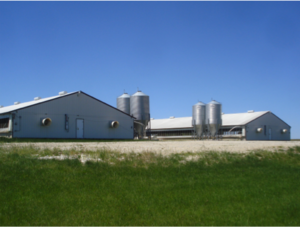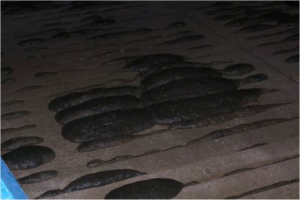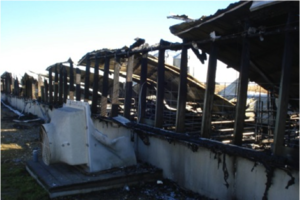Foaming in Deep-pit Swine Manure Storages
Introduction
Foam production in deep-pit manure storages is a growing concern for the U.S. swine industry. Deep-pit manure storages are commonly used in Mid-western states to store liquid swine manure (for up to a year) prior to land application. Reports of extensive spontaneous foam production in these facilities have been increasing since the late 2000’s.
Organic matter in the manure is anaerobically decomposed in the deep-pit storages; this decomposition produces carbon dioxide, methane and other biogases. Foam production traps these gases and accumulates high concentrations of methane (60-65%) [2]. This phenomenon has led to increased incidents of barn explosions and flash fires [1,2]. In addition to increased safety concerns, swine producers are also dealing with management concerns due to decreased storage capacities and reduced ventilation effectiveness.
To date a cause for the foaming has not been identified. One hypothesis is that the foam production is occurring as a consequence of the presence or activity of one or more bacterial populations, or from a by-product of bacterial populations present in the deep-pits [2]. A few studies have analyzed microbial community populations in deep-pit swine manure storages and detected differences in the microbial community composition in manure from foaming and non-foaming storages [4,6].
Physical and Chemical Environment
Classifying the environment physically or chemically is difficult for deep-pit manure storages due to the frequency of changes in feed rations used by the swine industry. However, generally speaking the pH typically ranges from 7.0 – 8.0 and the total solids content will range from 5.0 - 8.0 %. The temperature of the manure will follow a seasonal pattern, colder in the winter and warmer in the summer; the extent of these seasonal variations will depend on regional location. Measured manure temperatures in deep-pit storages range from 5oC - 30oC.
Microbial Communities and Processes
Information on the microbial communities present and microbial processes in deep-pit manure storages is limited. Two studies have used ARISA and T-RFLP DNA fingerprinting methods to analyze the microbial community composition from foaming and non-foaming storages [4,6]. The results from these studies indicate that there are different dominant bacteria populations in foaming and non-foaming swine manure. Manure samples from foaming facilities were found to have higher crude fat, copper, iron, and zinc in the manure, and a greater abundance of specific microbial groups [6]. However, the identification of specific bacterial populations was limited by the taxonomic resolution of the DNA fingerprinting approaches, and by the presence of previously uncharacterized populations.
Current Research
This is a relatively new area of research with limited published information, there are ongoing studies looking at identifying dominant microbial species and characterizing the physical and chemical properties among foaming and non-foaming manure [3].
References
[1] Choiniere, Y. 2004. Explosion of a deep-pit finishing pig barn, investigation report on biogas production. ASABE/CSAE Meeting Paper No. 044092. St. Joesph, MI.: ASABE
[2] Moody, L., R. Burns, R. Muhlbauer. (2009). Deep-pit swine facility flash fires and explosions: sources, occurrences, factors, and management. National Pork Board, Des Moines, IA.
[3] National Hog Farmer. 2012. Pit foaming continues to perplex researchers. Available at: http://nationalhogfarmer.com/environment/pit-foaming-continues-perplex-researchers
[4] Pepple, L.M., R. S. Gates, T. L. Funk, A. D. Kent. 2012. Microbial community analysis on liquid swine manure for foaming and non-foaming deep-pits. Proc. Of International Congress of Agricultural Engineering Conference. Valencia, Spain. July 8-12, Paper Number # C1353
[5] Rehberger, J., E. Davis, A. Veldkamp, T. Parrott, T. Rehberger. (2010). Comparison of nutrient and microbial profiles in foaming and non-foaming swine manure pits. J. Anim. Sci., 88, E-Suppl. 2.
[6] Rehberger, J., E. Davis, A. Baker, T. Parrott, A. Veldkamp, T. Rehberger. (2009). A preliminary comparison of the bacterial communities of foaming and non-foaming swine manure pits. J. Anim. Sci., 87, E-Suppl. 2.




